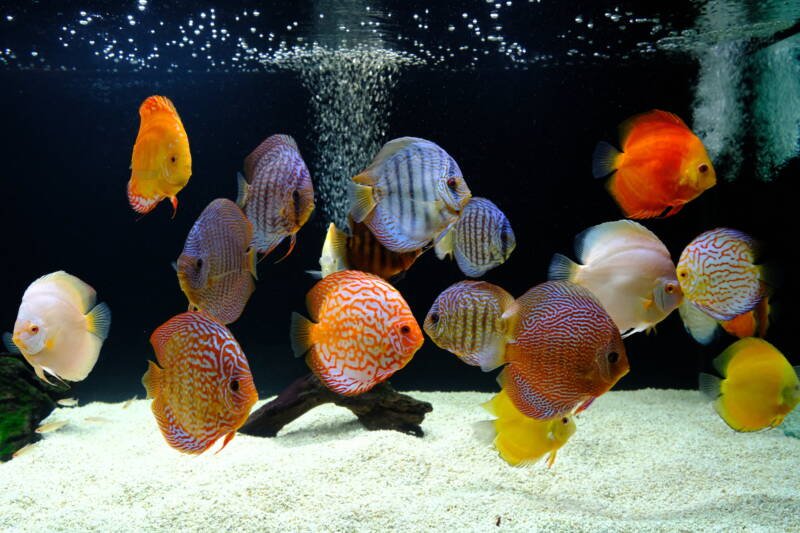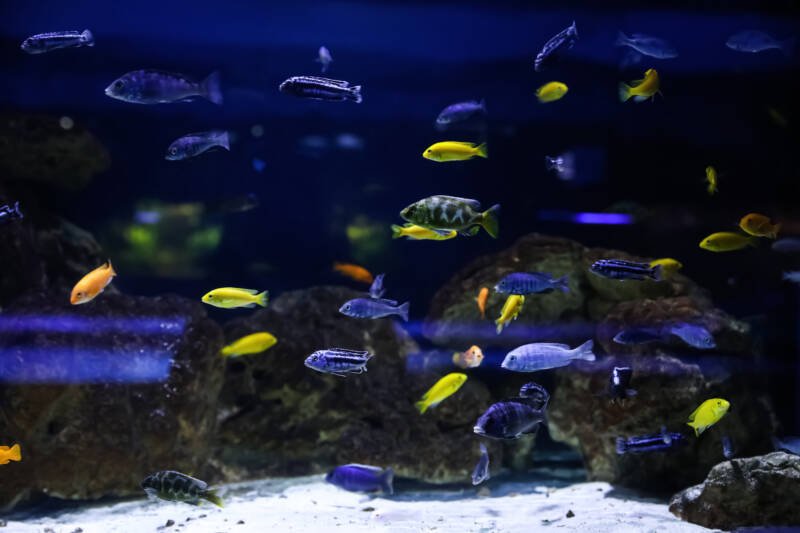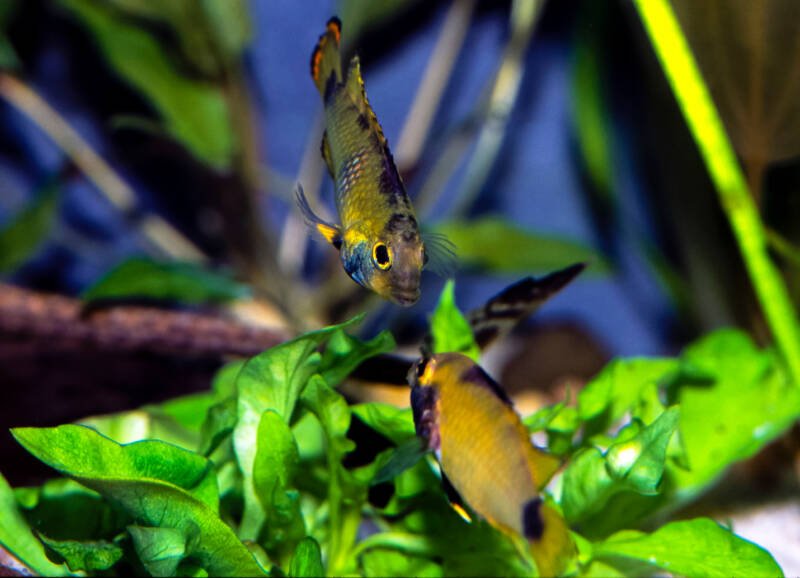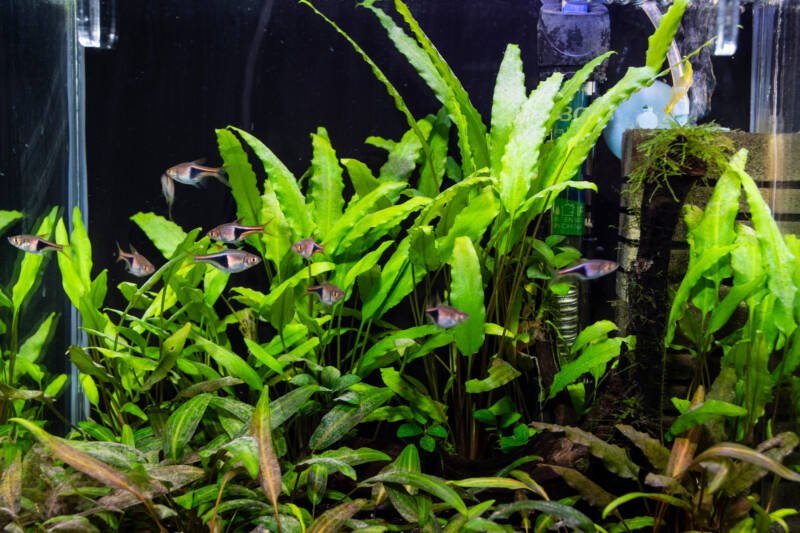What’s Nitrate?
Nitrate (NO-3) is a nitrogen-containing chemical that occurs in nature. It’s part of the natural process that recycles nutrients on land and in the water.
Nitrate is also manufactured to create fertilizers and a variety of other products. In lakes, rivers, and aquariums, high nitrate levels indicate a lot of pollution in the water.
Common causes of high nitrate in water are nitrogen-rich animal waste from agricultural areas and over-use of fertilizers.
In this article
How Does Nitrate Get into an Aquarium?

Some tap water supplies, usually well water, can contain nitrate. Adding this water to your aquarium can cause a nitrate build-up over time.
The main source of nitrate in freshwater aquariums is the breakdown of fish waste by bacteria, also known as biological filtration.
Biological Filtration and Nitrate
When you feed your fish flakes, pellets, and other foods, the protein is digested and used for energy and growth.
Ammonia is released into the water as a by-product of digestion. Ammonia is toxic to the fish.
Fortunately, bacteria living in the aquarium convert ammonia to nitrite and then to nitrate. This biological process is called the nitrogen cycle:
- Ammonia is released by the fish and is converted to nitrite,
- Bacteria convert nitrite into nitrate,
- Nitrate tends to build up in the aquarium water.
Ammonia and nitrite are harmful to aquatic life.
The good news is that the biological filter, powered by bacteria, quickly converts these toxins to relatively harmless nitrate.
Is Nitrate Bad for my Aquarium?
While ammonia and nitrite have been proven to be acutely toxic to freshwater fish, the effects of nitrate are still being studied.
Studies show that long-term exposure to elevated nitrate levels may weaken the fish and shorten their lifespan.
Accumulating nitrate is also a sign that the aquarium is probably heavily fed and not being maintained as well as it could be.
Dirty aquarium water also contains high levels of algae-promoting phosphate along with organic pollutants.
Poor water quality and a dirty tank is a proven cause of:
- Weakened immune system
- Disease outbreaks
- Dirty gravel and glass
- Cloudy water
Testing for Nitrate

It’s easy to test the nitrate level in your freshwater tank. Dip strips provide a quick look at the nitrate level. Liquid nitrate test kits take a little longer to use but provide increased accuracy.
You can use nitrate test kits to check your tap water for nitrate as well as your aquarium water.
Test results are reported as mg/l (milligrams per liter) or ppm (parts per million). These two units of measure (mg/l and ppm) are basically the same when it comes to testing aquarium water.
What Level of Nitrate is Safe in the Aquarium?

You’ll find lots of opinions on so-called “safe” nitrate levels for freshwater aquariums.
The limited research shows that nitrate sensitivity is specific to the type of fish and level of nitrate exposure. There is no one size fits all answer.
The truth is many tropical fish have been bred and kept in aquariums with nitrate levels well over 200 ppm. But keepers of sensitive fish, like dwarf cichlids, discus, and other harder-to-keep species, strive for nitrate levels of 10-20 ppm.
Here are a few recommendations. These are ideal levels. Use them as a rough guide for your tank.
- For most community tanks, keep the nitrate below 100 ppm,
- For specialty fish and freshwater invertebrates, maintain 20 ppm or less.
How do I Remove Nitrate?

There are several ways to manage nitrate levels in your freshwater aquarium. Use as many of these methods as possible to keep the nitrate levels under control.
Does Your Tap Water Contain Nitrate?
If the water you use to fill your tank or add top-off water contains nitrate, it’s going to be hard to maintain a low level.
Test your tap water. Nitrate in municipal water is regulated and should contain no more than 44 ppm nitrate (10 ppm as nitrate-nitrogen).
Well water is not regulated and may contain very high levels of nitrate.
If your water supply contains nitrate, you can remove it with a reverse osmosis filtration system. Reverse osmosis removes nitrate, heavy metals, and organics, like pesticides and other pollutants.
Reverse osmosis water is good for your aquarium and provides great-tasting drinking water.
Water Changes
Large water changes help to dilute accumulating nitrate. Making water changes with nitrate-containing tap water won’t help because you’re adding nitrate back to the tank.
Making small 10-20% water changes each month probably won’t help either. That’s because nitrate is continuously being created by the biological filter. Small dilutions, made once a month, can’t keep up with the natural nitrate build-up.
You can reduce nitrate by making a 25-35% water change every week or two. The water change will also remove dissolved organics and algae-promoting nutrients.
If you use a gravel siphon, you’ll be able to remove solid debris from the gravel bed at the same time.
Grow Live Plants
If your fish are compatible with live aquatic plants, you’re in luck. A densely planted aquarium will not have any measurable nitrate. The plants will use nitrate as a nitrogen fertilizer.
Other benefits include almost no algae growth, colorful fish, and a natural-looking aquarium.
Reduce Feeding
Every bit of eaten and uneaten fish food adds to the nitrate level. Many aquarists feed their fish too much food. The fish develop health problems due to too over-eating.
Too much food causes water quality problems, leading to algae growth and nitrate build-up. Cut back to twice-a-day feedings.
Don’t Over-Stock the Aquarium
An over-stocked aquarium will experience many water quality problems. The gravel will be dirty. The water may even develop a foul odor.
Fish will experience health problems. Your fish will be healthier and reach their full potential only if they live in a stress-free environment. Don’t pack the tank with fish.
Nitrate-Removers
There is a variety of products sold for removing nitrate from freshwater aquariums. Not all are effective. Some products contain bacteria that clean up the gravel.
The idea is to remove the organics before they break down into nitrate. This is a slow process and won’t be able to keep up with all the nitrate being added by fish waste and feeding.
Look for a filtration product that contains nitrate-removing resin. This type of product works by directly removing nitrate from water.
Final Thoughts
Nitrate is far less harmful than ammonia and nitrite.
There is no need to get stressed over maintaining a specific nitrate level. But it is a good idea to try some of the methods described above to reduce nitrate and improve the health of your fish and aquarium.
If you have a question or comment, please leave it below.